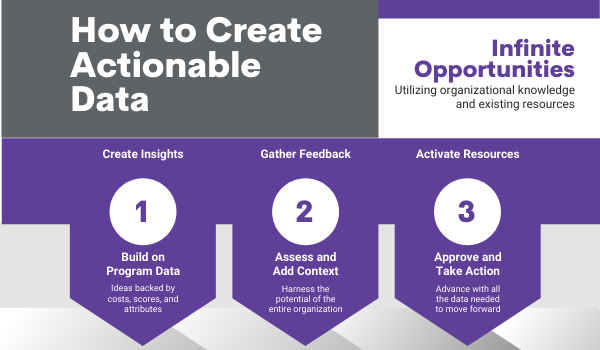According to the National Oceanic and Atmospheric Administration (NOAA), in 2022, the United States experienced 18 weather or climate disaster events1 that resulted in losses totaling more than $1 billion each.
To add some context, the average from 1980-2022 is 7.9 events per year.
Between unprecedented drought, floods, hurricanes, wildfires, and winter storms, extreme weather and climate events are impacting almost every region nationwide. To mitigate the effects of these events and prepare for future climate change, many local governments are implementing climate action plans to protect their residents and reinforce their infrastructures.
A climate action plan provides government leaders with science-backed strategies to reduce greenhouse gas emissions, establish clean energy targets, increase resilience, and set social and economic goals.
Set the Stage for Climate Action
Deploying a successful climate action plan doesn’t happen overnight. It requires extensive strategy, planning, and resources.
Budget for a climate action fund.
Although the need for a climate action plan is obvious, the way to pay for it often isn’t. Traditional line-item budgets obscure insights into how funds are used at the program level. This lack of visibility makes it difficult to allocate sufficient budget to programs that serve climate action goals.
To ensure budgets align with sustainability goals, many local governments are adopting the priority-based budgeting methodology to free up and redirect funding and pay for climate action initiatives
By pairing priority-based budgeting data with government budgeting software, budgeting teams can:
- Measure program and service alignment with sustainability goals.
- Prioritize programs that support climate action.
- Reallocate existing financial resources to climate action programs.
- Develop a budget proposal scoring matrix to transparently evaluate proposals across competing priorities.
- Apply a climate focused decision-making framework to ongoing budget decisions.
The city of Pittsburgh is a prime example of successful climate and equity budgeting through a priority-based budgeting framework.
Pittsburgh’s leadership has been taking steps to address climate change since 2007. However, a commitment to make the city carbon neutral by 2050 led to a series of challenges, and the city needed new strategies to reach this goal.
Priority-based budgeting allowed Pittsburgh to align elected officials, department leaders, staff, and community members and identify ways to free up, repurpose, and prioritize budgetary resources to fund climate and equity initiatives.
Read the full case study here.
Collaboration is key!
Climate change can’t be addressed in a vacuum. A whole-of-government approach, led by budget, sustainability and procurement leaders must be established for full collaboration in order to fund and implement real and lasting impact .
For example, the city of Flagstaff enlisted help from all departments and the community to prioritize its 2022-23 programmatic budget to free up funds for a carbon neutrality plan.
In addition, the city manager placed the city’s sustainability director on the budget team to help align priorities throughout the budgeting process.
Read the full case study to learn how reframing Flagstaff’s budget using priority-based budgeting uncovered more than $2 million for its carbon neutrality plan.
Internal alignment is just one factor in a successful climate action strategy. Local governments should also form partnerships with organizations in their region that produce massive emissions and have the potential and resources to reduce them.
Working with local institutions—like colleges, universities, hospitals, utilities, and technology providers—enables governments to increase the impact of their climate action plan and also defray some of the costs.
It may make sense for city governments to partner with stakeholders who are also “in the trenches.” Park managers and state and county governments have a vested interest in supporting regional climate action, so working together can help them expand the reach of programs and identify additional community needs and priorities.
Benefits of Climate Action Planning
In addition to safeguarding against climate change, climate action plans that include reducing greenhouse gas emissions, establishing environmental, social and governance (ESG) strategies, improving infrastructure, and providing broader access to clean and sustainable energy have far-reaching benefits for the community.
Improve the quality of life.
Some groups and areas within a community will experience the negative effects of climate change more than others, so equity is an essential consideration in climate action planning.
Priority-based budgeting helps governments deploy climate action programs with a focus on equity that directly benefit these groups and “frontline communities” to ensure the most vulnerable residents are protected.
Increase engagement.
The more visibility local governments give to climate action planning, goals, and outcomes, the more support they gain for climate action initiatives.
Engaging residents will make it easier to identify climate action needs and priorities within the community. This makes it easier to allocate funds where they will have the biggest impact.
When city employees are involved in climate action planning, they can provide insight into where program resources are not supporting sustainability outcomes, so that funding can be redirected to programs that support climate goals.
Expand economic opportunity.
Climate action planning provides an opportunity to attract new industries to your region or grow those already doing business in your community.
For example, a climate action plan that includes reducing greenhouse gas emissions and replacing traditional utilities with sustainable energy sources will require more businesses focused on climate technology, electric vehicles, “green” construction, and solar, wind, and water-power infrastructure.
It’s Time for Climate Action
Many cities are already feeling the effects of climate change, and those that aren’t need to start planning.
These five climate action planning tips can give you a jumping-off point. However, one of the first and most important things local governments must do is add new or reallocate revenue to increase climate action funds in the budget—while simultaneously taking advantage of Federal funding opportunities.
Download the 2022 Impact Report to learn how cities use priority-based budgeting to fund programs that support climate initiatives, equity, resilience, and other essential outcomes.








